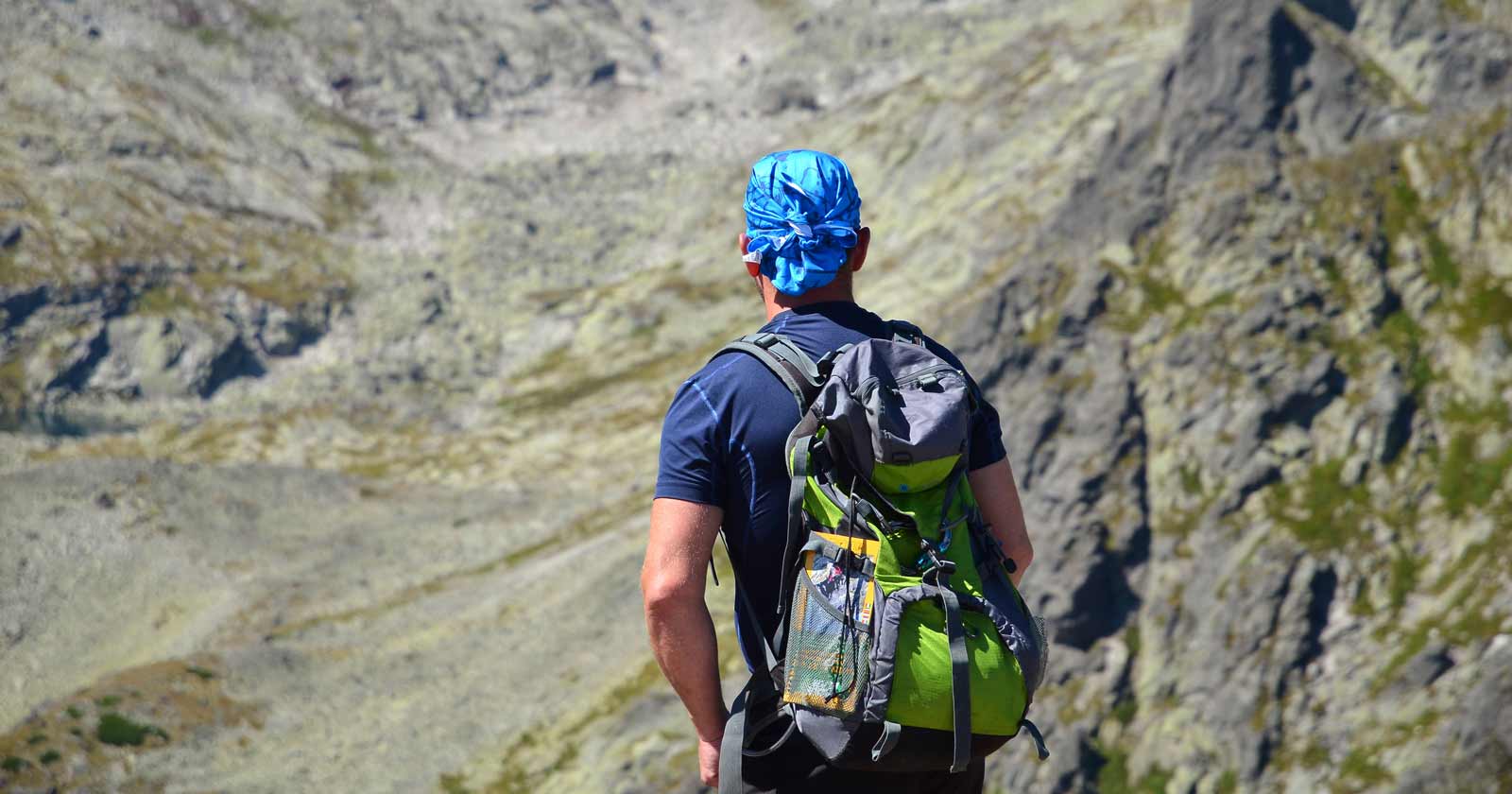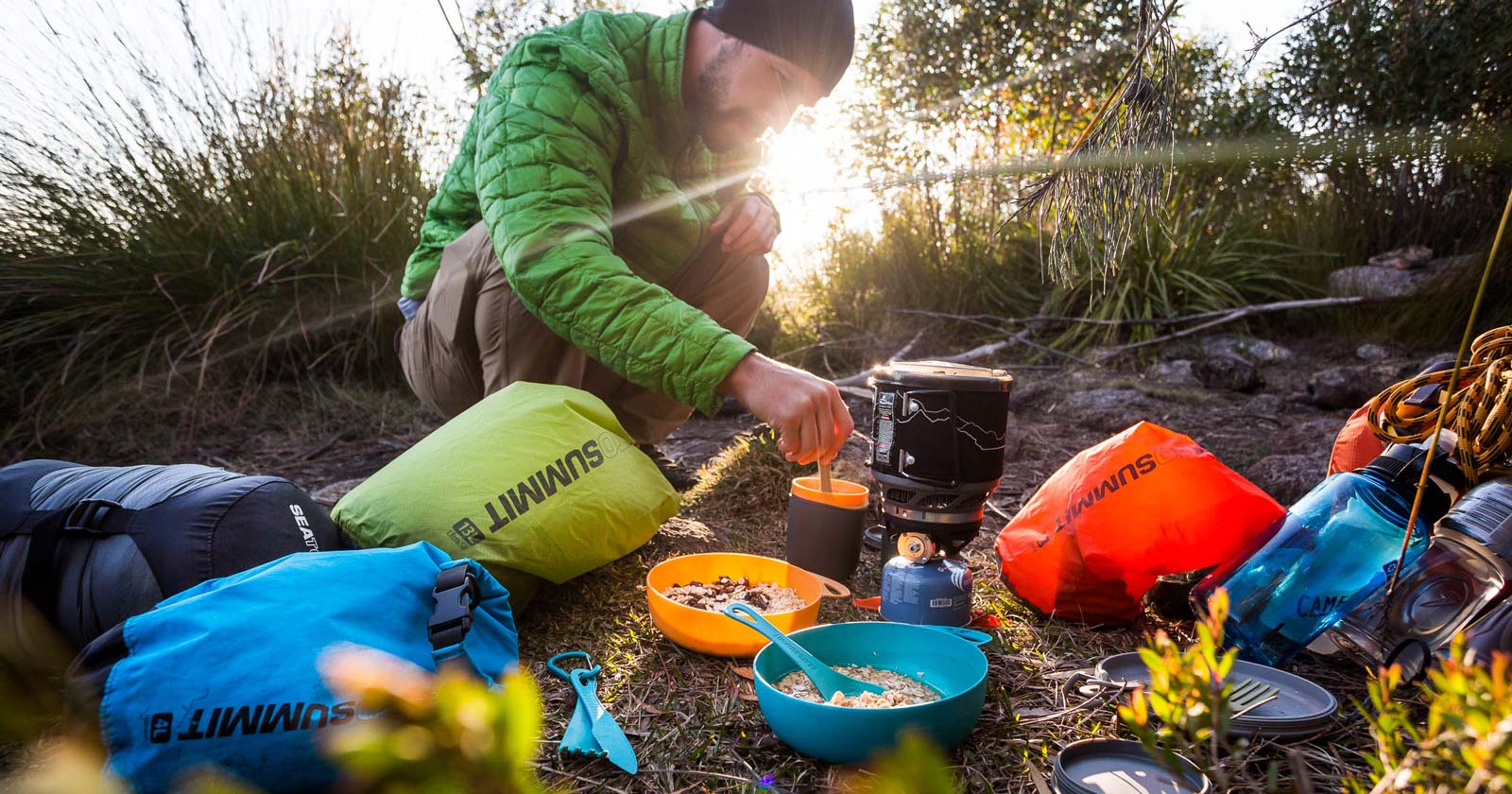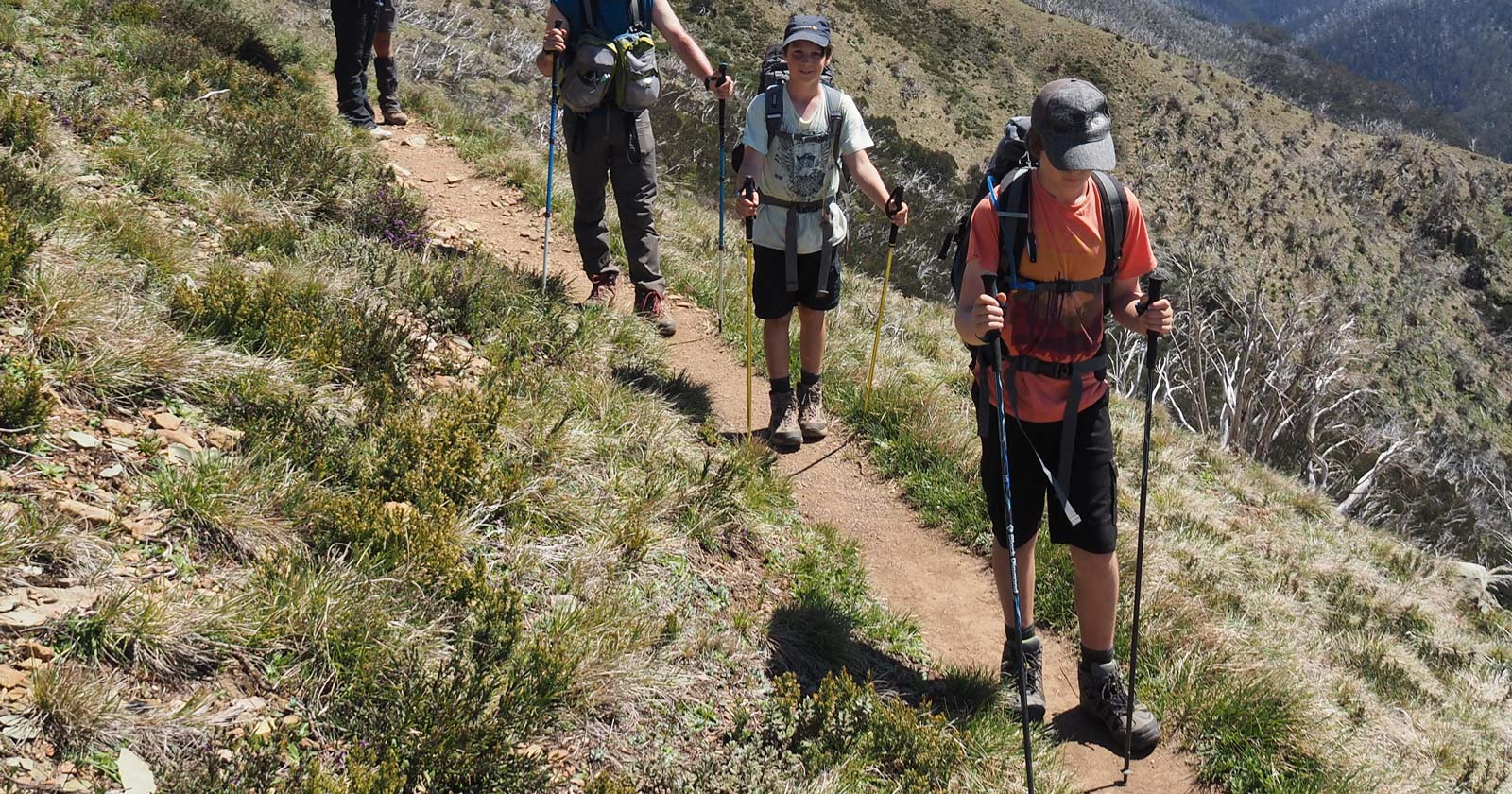Types of hiking tent pegs
In the world of hiking and camping, the tent stands as a symbol of shelter and comfort, providing a sanctuary amidst the wilderness. But behind every sturdy tent lies a network of unsung heroes – the tent pegs. These humble yet essential components play a pivotal role in securing your tent against the elements, ensuring a safe and enjoyable outdoor experience.
Tent pegs are an essential part of any hiking trip, and choosing the right ones can make a big difference in the security and stability of your tent. With so many different types of tent pegs available, it can be tough to know where to start. This blog post will provide a guide to choosing and using the right hiking tent pegs for your needs.
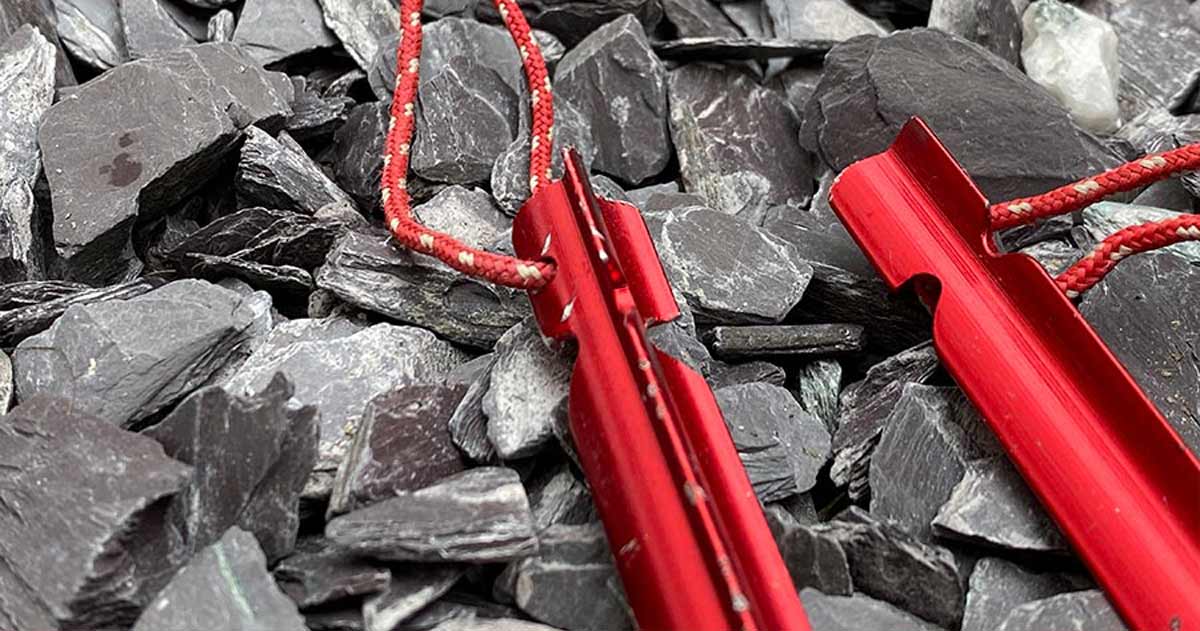
Y-pegs (Y-steaks)
Y-pegs, or Y-steaks, are a popular choice for hikers and campers because they’re versatile, lightweight, and durable. Their Y-shaped design provides excellent grip in the ground, making them ideal for securing tents and tarps on a variety of terrains, from hard to soft. Y-pegs are typically made of lightweight materials that are easy to carry on long hikes. They’re also sturdy enough to withstand the elements, so you can be confident that they’ll hold your shelter in place even in strong winds and rain.
One of the biggest advantages of Y-pegs is their versatility. They can be used to anchor tents and tarps in a range of ground types, including rocky soil and compacted sand. The Y-shape creates multiple points of contact with the ground, which improves resistance to pulling forces and reduces the risk of pegs pulling out. When choosing Y-pegs for your hiking gear, look for high-quality options that are both lightweight and durable. You want pegs that can provide secure and reliable anchoring for your shelter, so you can relax and enjoy your outdoor adventures without worry.
Benefits of Y-pegs
Y-pegs offer a number of benefits over other types of tent pegs, including:
- Excellent holding power: Y-pegs have a wide, triangular base that helps to distribute the weight of the tent evenly and prevents the stake from sinking into the ground. This makes them ideal for use in soft or sandy ground, where other types of pegs may pull out easily.
- Durability: Y-pegs are typically made from aluminum or titanium, which are both lightweight and durable materials. This makes them ideal for backpacking and other outdoor activities where weight is a concern.
- Ease of use: Y-pegs are easy to drive into the ground, even in hard or rocky soil. They also have a variety of features that make them easy to use, such as notches for attaching guy lines and hooks for preventing the lines from slipping off.
When to use Y-pegs
Y-pegs are a good choice for most camping and hiking trips. They are especially well-suited for use in soft or sandy ground, but they can also be used in hard or rocky ground. Y-pegs are also a good choice for camping in windy conditions, as they offer excellent holding power.
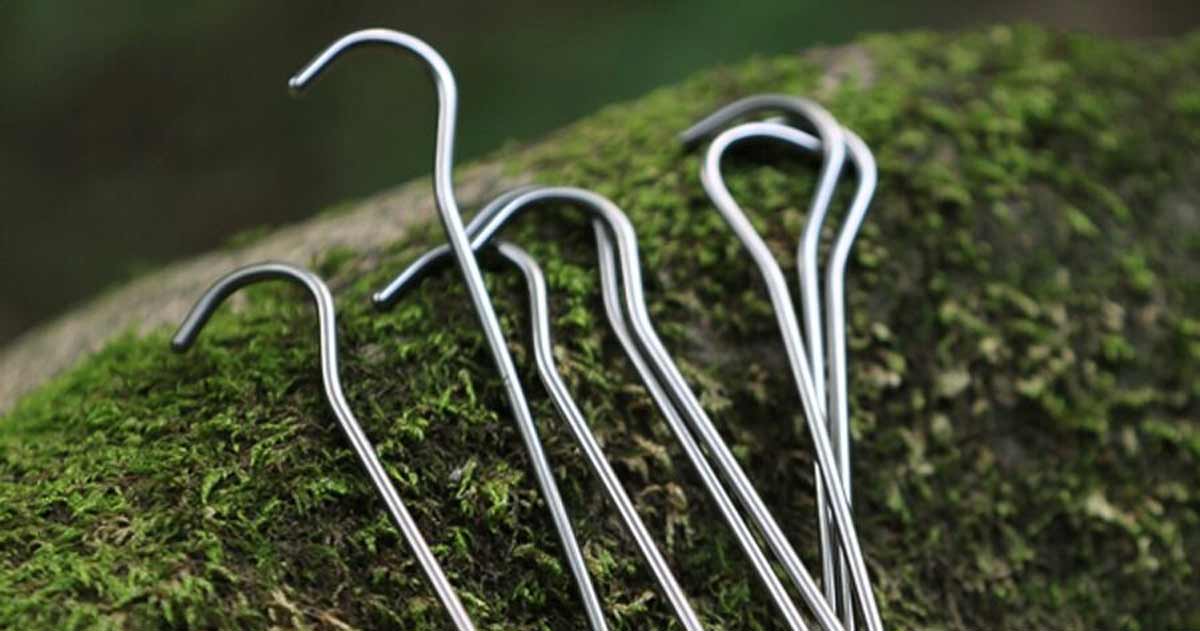
Shepherds hook pegs (Hook pegs)
Shepherd hook pegs are a must-have for hikers and outdoor enthusiasts who need to secure tents and tarps in difficult terrain, such as hard or rocky ground. They are typically made of durable lightweight materials, making them easy to carry on long hikes. One of the key features of shepherd hook pegs is their pointed design, which makes it easy to push them into tough surfaces and create a stable anchor for your tent. The hooked tip also prevents the guyline from slipping off, ensuring a secure setup even in windy conditions.
Hikers choose shepherd hook pegs for their versatility and reliability. They offer excellent holding power and stability in a variety of environments, making them ideal for camping, backpacking, and hiking in rugged terrain. When choosing shepherd hook pegs for your hiking gear, consider factors such as weight, durability, and compatibility with different ground types. With the right set of shepherd hook pegs, you can ensure a stable and secure shelter, so you can relax and enjoy your outdoor adventures.
Benefits of shepherd hook pegs
Shepherd hook pegs offer a number of benefits over other types of tent pegs, including:
Excellent holding power: Shepherd hook pegs have a long, sharp point that can penetrate hard or rocky ground, and a hook at the top that helps to keep the guyline from slipping off. This makes them ideal for use in challenging ground conditions where other types of pegs may pull out easily.
Durability: Shepherd hook pegs are typically made from aluminum or titanium, which are both lightweight and durable materials. This makes them ideal for backpacking and other outdoor activities where weight is a concern.
Ease of use: Shepherd hook pegs are easy to drive into the ground, even in hard or rocky soil. They also have a variety of features that make them easy to use, such as hooks for preventing the guy lines from slipping off.
Lightweight: Shepherd hook pegs are typically lighter than other types of tent pegs, such as steel pegs. This makes them a good choice for backpackers and other campers who need to keep their weight down.
When to use shepherd hook pegs
Shepherd hook pegs are a good choice for camping or backpacking in areas with hard or rocky ground. They are also a good choice for camping in windy conditions, as they offer excellent holding power.
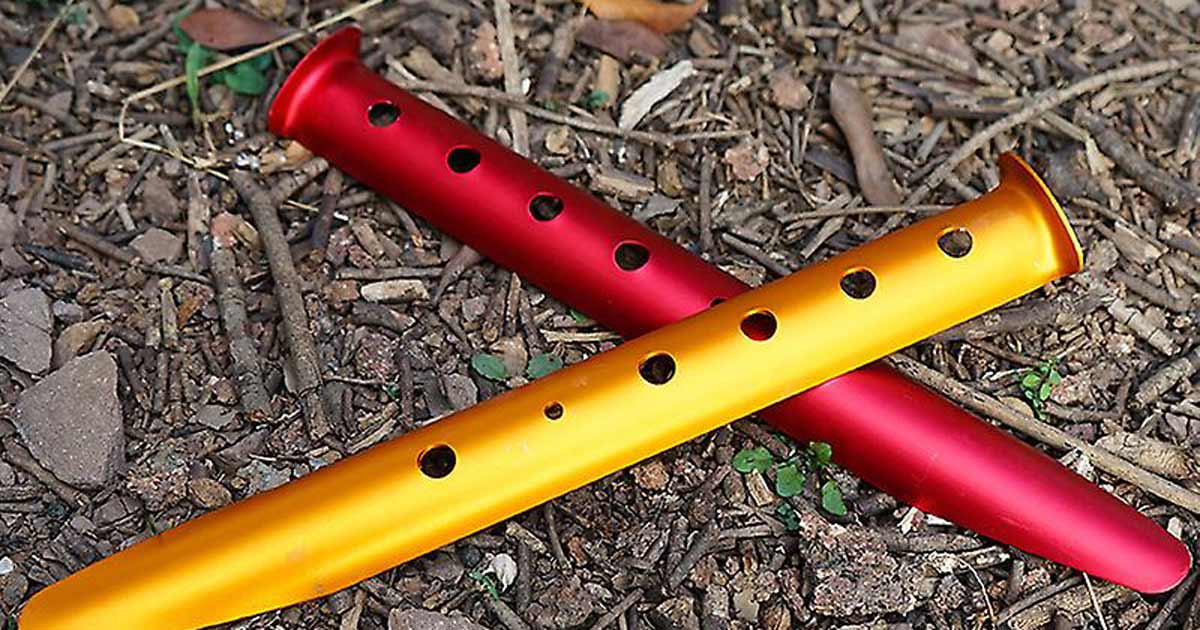
Snow Pegs (Sand pegs)
If you are planning on camping in the snow or on sand, snow pegs are an essential piece of gear. Regular tent pegs will not work in snow, as they will simply sink into the soft surface. Snow pegs are designed to stay anchored in snow, even in windy conditions. Snow pegs are an essential tool for camping in the snow. They help to keep your tent secure and prevent it from blowing away in windy conditions. If you are planning on camping in the snow, be sure to pack snow pegs.
Types of snow pegs
There are two main types of snow pegs:
- U-shaped snow pegs: U-shaped snow pegs are the most common type of snow peg. They have a wide, U-shaped base that helps them to stay anchored in snow. U-shaped snow pegs are typically made from aluminum or titanium, and they come in a variety of lengths.
- T-shaped snow pegs: T-shaped snow pegs are a newer type of snow peg that is becoming increasingly popular. They have a T-shaped base that helps them to stay anchored in snow, and they also have a hook at the top that helps to keep the guyline from slipping off. T-shaped snow pegs are typically made from stronger materials than U-shaped snow pegs, and they are longer, which gives them more holding power.
Choosing the right snow pegs
When choosing snow pegs, there are a few factors to consider:
- Snow conditions: How deep and how hard is the snow where you will be camping? If the snow is deep and hard, you will need longer and stronger snow pegs.
- Tent size: The size of your tent will determine how many snow pegs you need. Larger tents require more pegs.
- Wind conditions: If you are camping in windy conditions, you will need to use more snow pegs and longer snow pegs.
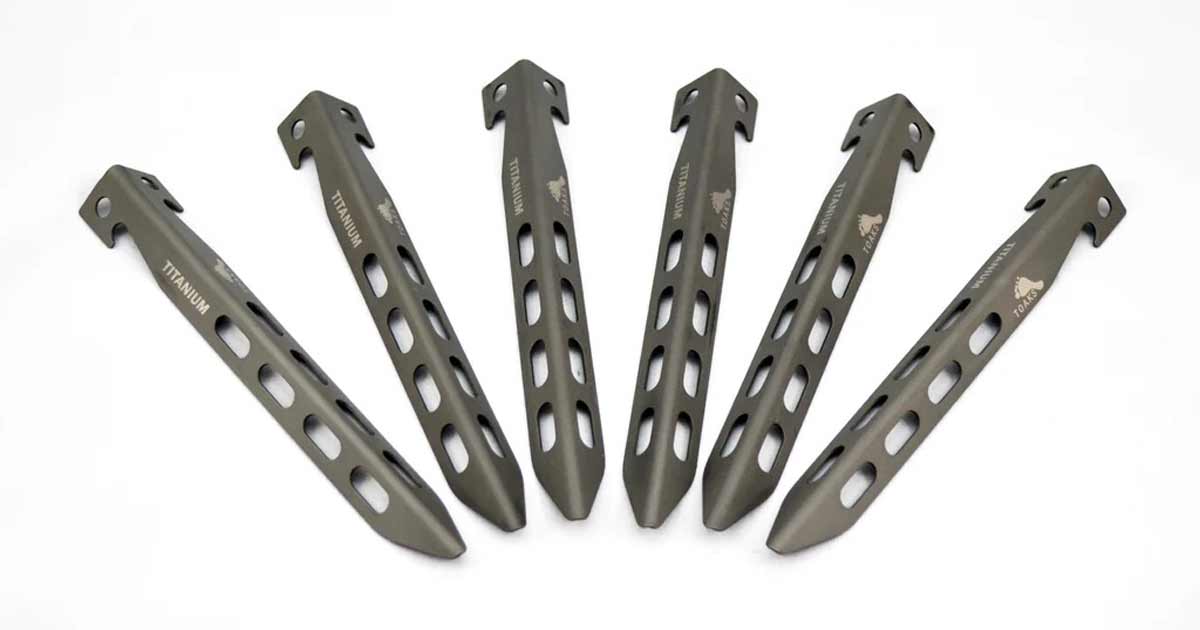
Lightweight titanium pegs
Titanium pegs are a popular choice for overnight or multi-day hikers because they are lightweight and durable. Titanium is a strong metal that is also lightweight, making it ideal for backpacking gear. Titanium pegs are also rust-resistant, which is important for gear that will be exposed to the elements. Lightweight titanium pegs are a must-have for backpackers. They are lightweight, durable, and versatile. If you are looking for a reliable and lightweight way to secure your tent, lightweight titanium pegs are the way to go.
Here’s a few lightweight options you could consider.
V Pegs: V pegs are tent pegs with a V-shaped head. This gives them a better grip on the ground than traditional tent pegs, making them more resistant to wind. V pegs are typically made of aluminum or titanium, making them lightweight and durable. They are a good choice for hikers and backpackers who need tent pegs that can withstand being driven into the ground and pulled out again.
Tube Steaks: Tube steaks are tent pegs that are made of a hollow tube. This makes them very strong and durable, and they can be driven into hard ground with ease. Tube steaks are typically made of steel or aluminum, and they are a good choice for campers who need tent pegs that can withstand heavy winds and rain.
J-Steak: J-stakes are tent pegs with a J-shaped bend. This makes them easy to drive into the ground, and they provide good stability in windy conditions. J-stakes are typically made of aluminum or steel, and they are a good choice for campers who need tent pegs that are easy to use and can withstand moderate winds.
Nail Pegs: Nail pegs are tent pegs that are made of a single piece of metal. This makes them very strong and durable, and they can be driven into hard ground with ease. Nail pegs are typically made of steel, and they are a good choice for campers who need tent pegs that can withstand heavy winds and rain.
There are a number of benefits to using lightweight titanium pegs for backpacking:
- Weight: Titanium pegs are significantly lighter than other types of tent pegs, such as steel pegs. This is a major advantage for backpackers, who are always looking to save weight.
- Durability: Titanium is a strong metal that is also lightweight. This makes titanium pegs durable and reliable.
- Rust resistance: Titanium is rust-resistant, which is important for gear that will be exposed to the elements.
- Versatility: Titanium pegs can be used in a variety of ground conditions, including soft, sandy ground, hard ground, and even snow.
Choosing the right lightweight titanium pegs
When choosing lightweight titanium pegs for backpacking, there are a few factors to consider:
- Length: The length of the pegs will depend on the type of ground you will be camping in. If you will be camping in soft ground, you will need shorter pegs. If you will be camping in hard ground, you will need longer pegs.
- Shape: The shape of the pegs will also affect their performance. Y-shaped pegs are good for soft ground, while shepherd hook pegs are good for hard ground.
- Weight: As mentioned above, titanium pegs are lightweight. However, there is some variation in weight between different brands and models. Choose pegs that are lightweight enough for your needs, but still durable.
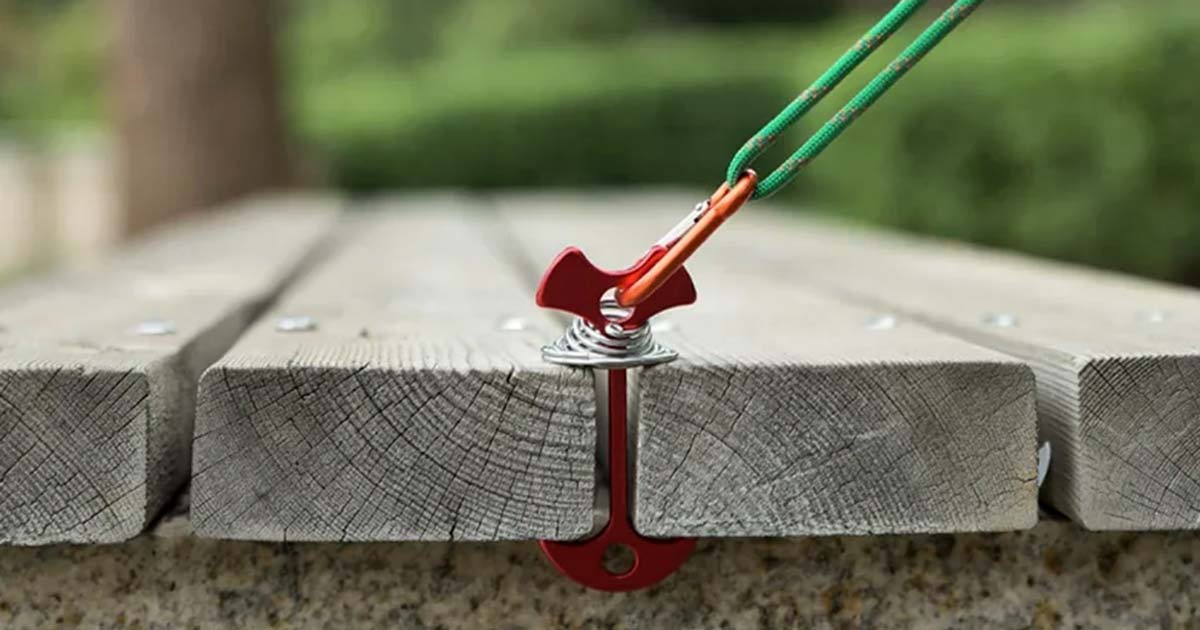
Platform tent pegs (Deck anchors)
When securing a tent to a timber platform, you have a few options besides traditional tent pegs. Many platforms have pre-installed hooks, ropes, chains or designated areas for attaching guylines. If available, this method distributes tension effectively.
Platform tent pegs, also known as spring-loaded tent pegs, deck anchors, fishbone tent anchors, or anchor plates, are specifically designed for securing tents on wooden platforms commonly found in campgrounds and wilderness areas. Unlike traditional tent stakes, which are driven into the ground, platform pegs work by gripping the edges or gaps between the wooden planks of the platform.
Here’s some key features of platform tent pegs:
- Design: They typically have a flat base plate with a spring-loaded mechanism that clamps onto the platform edge. Some models have teeth or hooks for added grip.
- Material: They are usually made from lightweight and durable materials such as aluminum or plastic.
- Weight: They are generally lighter than traditional tent stakes, making them ideal for backpacking and ultralight camping.
- Ease of use: They are easy to use and don’t require hammering or any tools. Simply slide the base plate between the boards and twist to secure under the platform edge. The spring mechanism engages to hold the anchor in place.
- Low impact: They leave minimal impact on the platform compared to traditional stakes that can damage the wood.
Here’s some of the different types of platform tent pegs available:
Cup anchors: These have a round base plate that cups the edge of the platform. They are simple and effective, but may not work well on platforms with wide gaps between the planks.
Spring-loaded cup anchors: Combine the simple design of a cup anchor with a spring mechanism for added holding power, making them suitable for a wider range of platform thicknesses and weather conditions. They are easy to use but might offer slightly less grip compared to fishbone anchors on platforms with large gaps.
Fishbone anchors: These have a flat base plate with multiple tines that spread out and grip the platform from underneath. They offer more holding power than cup anchors and work well on platforms with wider gaps.
Sling anchors: These have a loop or strap that goes around the edge of the platform and tightens with a buckle. They are versatile and can be used on a variety of platform shapes and sizes.
The best type of platform tent peg for you will depend on the following factors:
- The type of platform: Consider the material, thickness, and spacing of the planks.
- The weather conditions: In high winds or wet conditions, you will need a peg with more holding power.
- The weight of your tent: Heavier tents will require more robust pegs.
- Your personal preference: Some people prefer the ease of use of cup anchors, while others prefer the versatility of sling anchors.
Platform tent pegs offer a convenient, lightweight, and low-impact way to secure your tent on wooden platforms. With a variety of options available, you can find the perfect peg for your next camping adventure. So, whether you’re a seasoned backpacker or a casual camper, consider giving platform tent pegs a try – they might just become your new go-to.
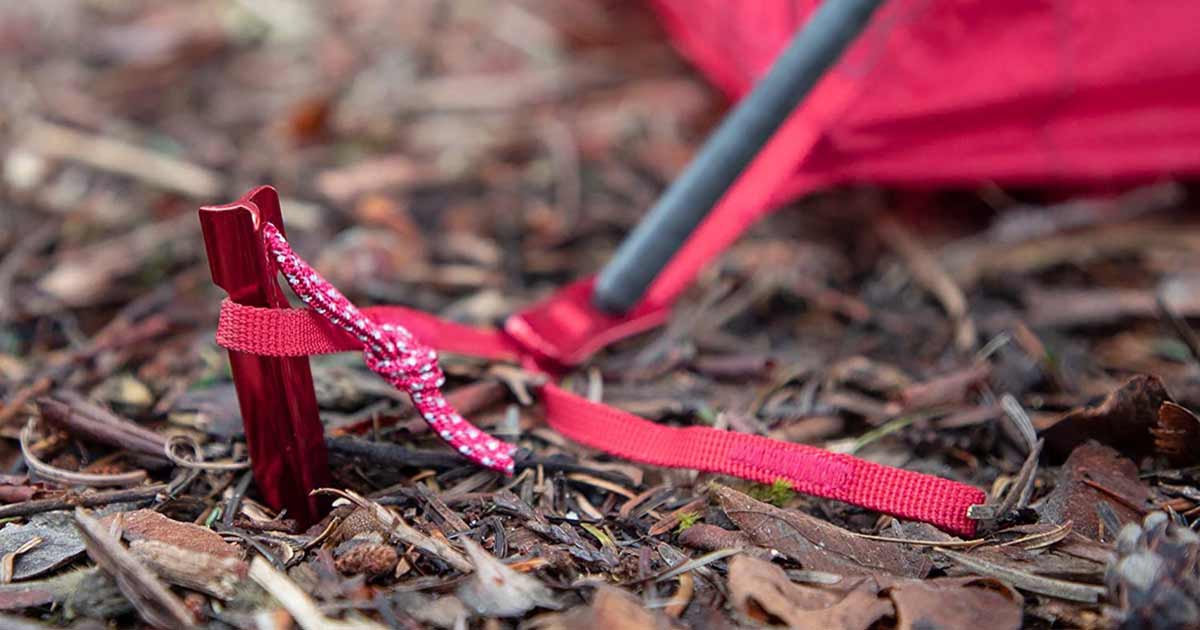
Using tent pegs
To use tent pegs other than platform anchors, follow these steps:
- Clear the ground of any rocks or debris.
- Drive the peg into the ground until it is secure. Ideally, use a tent hammer (if you are carrying one) to drive the peg in, and be careful not to overstrike it, as this could damage the peg.
- Attach the guyline to the peg and tighten it until the tent is taut.
- Repeat steps 2 and 3 for all of the tent pegs.
Tips for using hiking tent pegs:
- If the ground is hard, you can make it easier to drive in the pegs by softening it with water.
- If you are camping in windy conditions, use more pegs than you normally would.
- If you are camping in snow, you can use snow pegs to secure your tent. Snow pegs are longer and have wider bases than regular tent pegs, which helps them to stay anchored in the snow.
Choosing the right tent pegs
Which type of tent peg is right for you? The best type of tent peg for you will depend on your specific needs. If you are a hiker or backpacker who needs lightweight and durable tent pegs, V pegs or titanium nail pegs are a good choice. If you are a camper who needs tent pegs that can withstand heavy winds and rain, tube steaks or steel nail pegs are a good choice. Ultimately, the best way to choose the right tent pegs for you is to experiment with different types and see what works best for your needs.
When choosing hiking tent pegs, there are a few factors to consider:
- Ground conditions: Choose tent pegs that are appropriate for the ground conditions you will be camping in. For example, if you are camping in soft ground, you will need longer and wider pegs.
- Tent size: The size of your tent will also determine what type of pegs you need. Larger tents require more pegs, and stronger pegs.
- Weight: If you are hiking long distances, you will want to choose lightweight pegs. However, you don’t want to sacrifice strength for weight, especially if you are camping in challenging conditions.
- Durability: Tent pegs should be durable enough to withstand being driven into the ground and pulled out again.
- Price: Tent pegs can range in price from a few dollars to over $20 each. Choose a price range that fits your budget.
Hiking tent pegs are an essential part of any hiking trip. By choosing the right pegs and using them correctly, you can help to ensure that your tent is secure and stable, even in challenging conditions. You may even consider it a good idea to bring a variety of tent pegs with you on your hike, so that you have the right pegs for any ground conditions you encounter.
